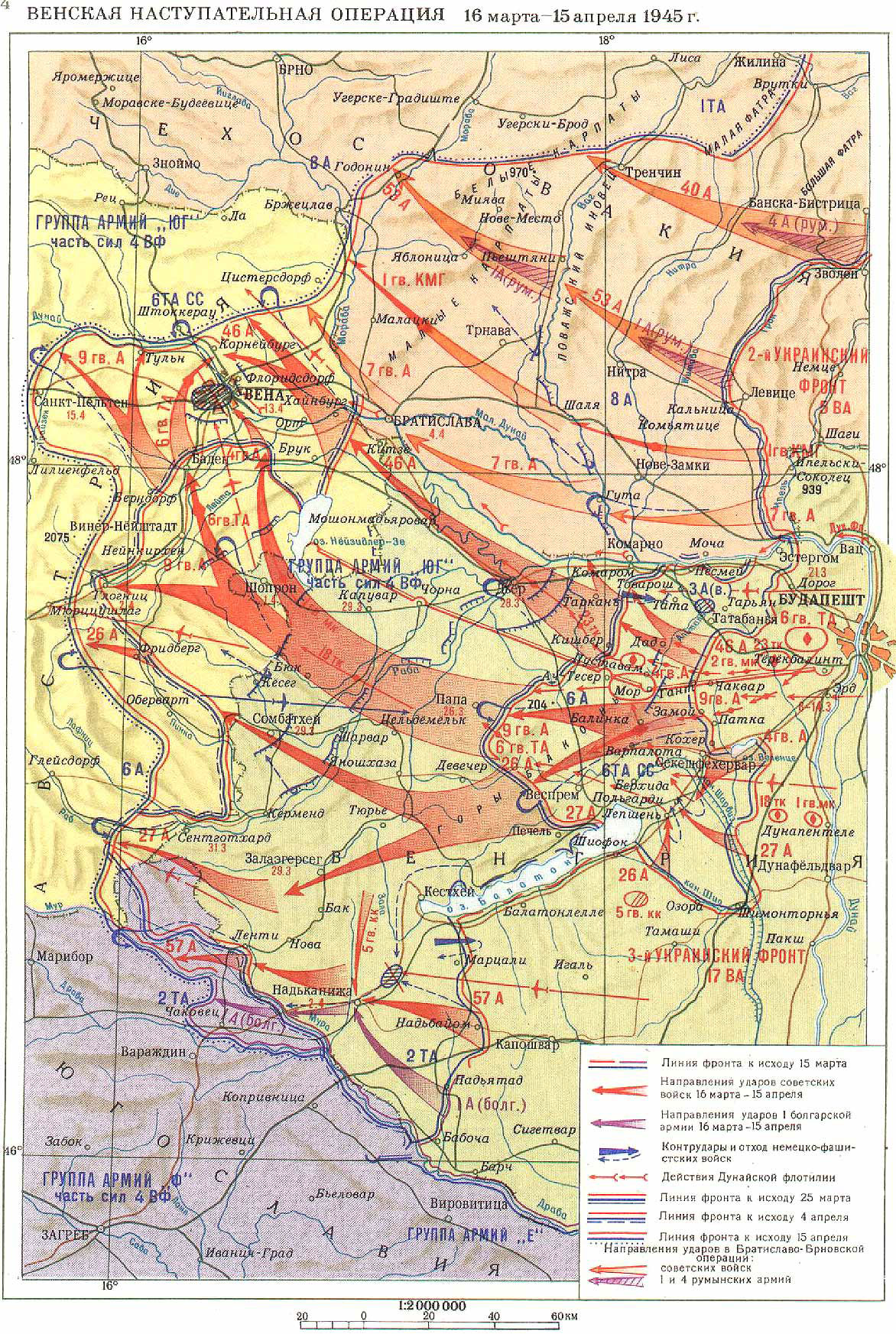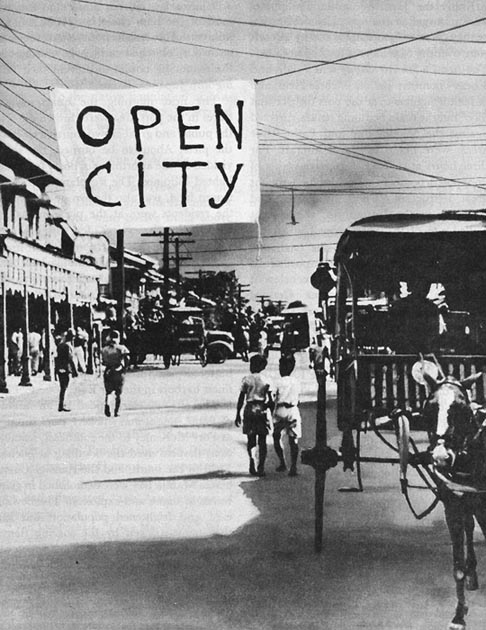|
Vienna Offensive
The Vienna offensive was an offensive launched by the Soviet 2nd and 3rd Ukrainian Fronts in order to capture Vienna, Austria, during World War II. The offensive lasted from 16 March to 15 April 1945. After several days of street-to-street fighting, the Soviet troops captured the city. Background Vienna had been bombarded continuously for the year before the arrival of Soviet troops, and many buildings and facilities had been damaged and destroyed. Joseph Stalin reached an agreement with the Western Allies prior to April 1945 concerning the relative postwar political influence of each party in much of Eastern and Central Europe; however, these agreements said virtually nothing about the fate of Austria, then officially considered to be merely the Ostmark area of Greater Germany after the Anschluss. As a result, the success of a Soviet offensive against Austria and subsequent liberation by the Red Army of a large part of the country would have been very beneficial for subsequ ... [...More Info...] [...Related Items...] OR: [Wikipedia] [Google] [Baidu] |
Eastern Front (World War II)
The Eastern Front of World War II was a Theater (warfare), theatre of conflict between the European Axis powers against the Soviet Union (USSR), Polish Armed Forces in the East, Poland and other Allies of World War II, Allies, which encompassed Central Europe, Eastern Europe, Northern Europe, Northeast Europe (Baltic states, Baltics), and Southeast Europe (Balkans) from 22 June 1941 to 9 May 1945. It was known as the Great Patriotic War (term), Great Patriotic War in the Soviet Union – and still is in some of its successor states, while almost everywhere else it has been called the ''Eastern Front''. In present-day German and Ukrainian historiography the name German-Soviet War is typically used. The battles on the Eastern Front of the Second World War constituted the largest military confrontation in history. They were characterised by unprecedented ferocity and brutality, wholesale destruction, mass deportations, and immense loss of life due to combat, starvation, expos ... [...More Info...] [...Related Items...] OR: [Wikipedia] [Google] [Baidu] |
Operation Spring Awakening
Operation Spring Awakening (german: Unternehmen Frühlingserwachen) was the last major German offensive of World War II. The operation was referred to in Germany as the Plattensee offensive and in the Soviet Union as the Balaton defensive operation. It took place in Western Hungary on the Eastern Front and lasted from 6 March until 15 March, 1945. The objective was to secure the last significant oil reserves still available to the European Axis powers and prevent the Red Army from advancing towards Vienna. It was a failure for Nazi Germany. The operation, initially planned for 5 March, began after German units were moved in great secrecy to the Lake Balaton (german: Plattensee) area. Many German units were involved, including the 6th Panzer Army and its subordinate Waffen-SS divisions after being withdrawn from the failed Ardennes offensive on the Western Front. The Germans attacked in three prongs: ''Frühlingserwachen'' in the Balaton-Lake Velence-Danube area, ''Eisbrecher' ... [...More Info...] [...Related Items...] OR: [Wikipedia] [Google] [Baidu] |
Open City
In war, an open city is a settlement which has announced it has abandoned all defensive efforts, generally in the event of the imminent capture of the city to avoid destruction. Once a city has declared itself open the opposing military will be expected under international law to peacefully occupy the city rather than destroy it. According to the Protocol I of the Geneva Conventions, it is forbidden for the attacking party to "attack, by any means whatsoever, non-defended localities". The intent is to protect the city's civilians and cultural landmarks from a battle which may be futile. Attacking forces do not always respect the declaration of an "open city". Defensive forces will occasionally use the designation as a political tactic as well. In some cases, the declaration of a city to be "open" is made by a side on the verge of defeat and surrender; in other cases, those making such a declaration are willing and able to fight on but prefer that the specific city be spared. Of ... [...More Info...] [...Related Items...] OR: [Wikipedia] [Google] [Baidu] |
King Michael's Coup
King is the title given to a male monarch in a variety of contexts. The female equivalent is queen, which title is also given to the consort of a king. *In the context of prehistory, antiquity and contemporary indigenous peoples, the title may refer to tribal kingship. Germanic kingship is cognate with Indo-European traditions of tribal rulership (c.f. Indic ''rājan'', Gothic ''reiks'', and Old Irish ''rí'', etc.). *In the context of classical antiquity, king may translate in Latin as '' rex'' and in Greek as ''archon'' or ''basileus''. *In classical European feudalism, the title of ''king'' as the ruler of a ''kingdom'' is understood to be the highest rank in the feudal order, potentially subject, at least nominally, only to an emperor (harking back to the client kings of the Roman Republic and Roman Empire). *In a modern context, the title may refer to the ruler of one of a number of modern monarchies (either absolute or constitutional). The title of ''king'' is used ... [...More Info...] [...Related Items...] OR: [Wikipedia] [Google] [Baidu] |
Kingdom Of Romania
The Kingdom of Romania ( ro, Regatul României) was a constitutional monarchy that existed in Romania from 13 March ( O.S.) / 25 March 1881 with the crowning of prince Karl of Hohenzollern-Sigmaringen as King Carol I (thus beginning the Romanian royal family), until 1947 with the abdication of King Michael I of Romania and the Romanian parliament's proclamation of the Romanian People's Republic. From 1859 to 1877, Romania evolved from a personal union of two vassal principalities (Moldavia and Wallachia) under a single prince to an autonomous principality with a Hohenzollern monarchy. The country gained its independence from the Ottoman Empire during the 1877–1878 Russo-Turkish War (known locally as the Romanian War of Independence), when it also received Northern Dobruja in exchange for the southern part of Bessarabia. The kingdom's territory during the reign of King Carol I, between 13 ( O.S.) / 25 March 1881 and 27 September ( O.S.) / 10 October 1914 is sometimes referred ... [...More Info...] [...Related Items...] OR: [Wikipedia] [Google] [Baidu] |
Danubian Lowland
::''The Serbian lowland is treated under Danube Plain (Serbia)'' The Danubian Lowland or Danube Lowland () is the name of the part of Little Alföld (Slovak: ''Malá dunajská kotlina'') situated in Slovakia, located between the Danube, the Little Carpathians and all other parts of the Western Carpathians. In terms of geomorphology, it forms one unit together with the Neusiedl Basin (''Neusiedler Becken'') in Austria and the Győr Basin (''Győri-medence'') in Hungary. It is an extensive tectonic depression filled with layers of Neogene Quaternary to a height of between 100 and 350 meters. It consist of the following two parts: * Danubian Hills (also translated as Danubian Upland) in the north * Danubian Flat (also translated as Danubian Plain) in the south Many urban and other settlements can be found in this primarily agricultural area. The towns Topoľčany, Nové Zámky, Komárno, Levice, Dunajská Streda and Galanta are administrative centers. They are centers of indust ... [...More Info...] [...Related Items...] OR: [Wikipedia] [Google] [Baidu] |
Nitra (river)
The Nitra ( Slovak: Nitra, german: Neutra, hu, Nyitra) is a river in western Slovakia. It flows into the Váh river in Komoča. Its source is in the Malá Fatra (Lesser Fatra) mountains north of Prievidza. The river Nitra passes through the towns of Bojnice, Topoľčany, Nitra and Nové Zámky. It is long and its basin size is . The old branch of the Nitra, ''Stará Nitra'', branches off near Nové Zámky and flows into the Váh close to its confluence with the Danube in Komárno Komárno, ( hu, Komárom, german: Komorn, sr, Коморан, translit=Komoran), colloquially also called ''Révkomárom, Öregkomárom, Észak-Komárom'' in Hungarian language, Hungarian; is a town in Slovakia at the confluence of the Danube an .... References Rivers of Slovakia {{Slovakia-river-stub ... [...More Info...] [...Related Items...] OR: [Wikipedia] [Google] [Baidu] |
Hron
The Hron ( sk, Hron; german: Gran; hu, Garam; la, Granus) is a long left tributary of the DanubePlán manažmentu povodňového rizikavčiastkovom povodí Hrona p. 38 and the second-longest river in . It flows from its source in the Low Tatra Mountains (below ) through central and southern Slovakia, emptying into the Danube near |
Nagykanizsa
Nagykanizsa (; hr, Velika Kaniža/Velika Kanjiža, or just ''Kaniža/Kanjiža''; german: Großkirchen, Groß-Kanizsa; it, Canissa; sl, Velika Kaniža; tr, Kanije), known colloquially as Kanizsa, is a medium-sized city in Zala County in southwestern Hungary. It is a city with county rights. It lies not far from Lake Balaton at the meeting point of five routes. For centuries the town has been a connecting link. Goods from Slavonia were transported to Graz via Nagykanizsa, and the town played an important role in the trade from the Adriatic Sea to the Alps, Alpine region, Vienna, and Budapest. History The city's oldest Roman era ruins were uncovered in the 1960s. Later, during the Middle Ages, it became one of the most important strongholds of the Hungarian Kingdom. The fortress had a significant role in the southern shield line of Hungary, keeping the whole of Western Europe safe from the attacks of the Ottoman Empire. The name Kanizsa was first mentioned in a document in 124 ... [...More Info...] [...Related Items...] OR: [Wikipedia] [Google] [Baidu] |
Sopron
Sopron (; german: Ödenburg, ; sl, Šopron) is a city in Hungary on the Austrian border, near Lake Neusiedl/Lake Fertő. History Ancient times-13th century When the area that is today Western Hungary was a province of the Roman Empire, a city called ''Scarbantia'' stood here. Its forum was located where the main square of Sopron can be found today. During the Migration Period, Scarbantia was believed to be deserted. When Hungarians arrived in the area, the city was in ruins. From the 9th to the 11th centuries, Hungarians strengthened the old Roman city walls and built a castle. The city was named in Hungarian after a castle steward named ''Suprun''. In 1153, it was mentioned as an important city. In 1273, King Otakar II of Bohemia occupied the castle. Even though he took the children of Sopron's nobility with him as hostages, the city opened its gates when the armies of King Ladislaus IV of Hungary arrived. Ladislaus rewarded Sopron by elevating it to the rank of free ro ... [...More Info...] [...Related Items...] OR: [Wikipedia] [Google] [Baidu] |







